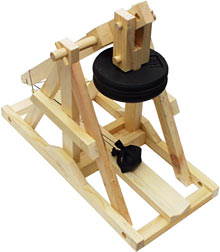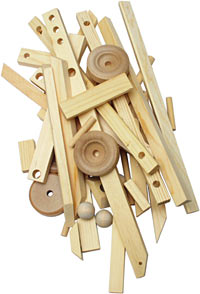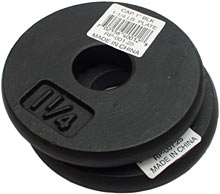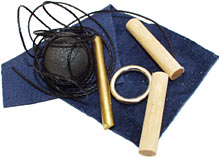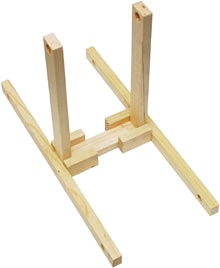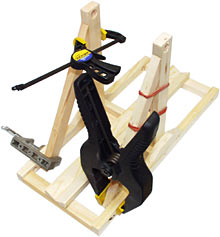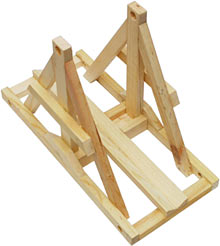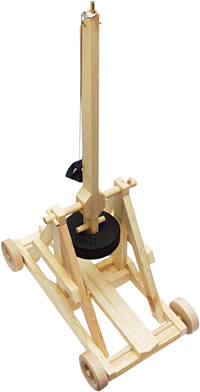
Tabletop Trebuchet kit
Review date: 24 December 2001. Last modified 03-Dec-2011.
There was artillery before there was gunpowder.
Technically, "artillery" can be said to be any device that discharges a missile. A handgun, bow, sling, blowgun or woomera qualifies. But the more popular definition is narrower, and doesn't cover things that fit in a pool cue case.
Talk about artillery, and most people will think of a big crew-served weapon which, if you shoot one unfortunate individual with it, will at the very least rip him into bits. Before gunpowder, such things existed, and they were all great big missile-hurlers made mainly of wood. The most powerful - and most efficient - of them all were the trebuchets.
Again, there's a blurring of definition, here. The general Middle French word "trebuchet" can be used to describe any mechanical rock-thrower, and there were various types. But, again, there's a tighter definition of a trebuchet, which specifies that it's a gravity-powered mechanical slinging machine. A pivoted arm with the pivot off-centre and weights solidly connected to, or hanging from, the short end. On the long end of the arm, a sling is attached with two ropes, one of which is fixed to the end of the arm and the other of which is hooked over a pin sticking out of the arm's end. In the sling, something that the other guys would rather not have thrown at them.
Trebuchets generally flung rocks and purpose-made metal missiles, but they also worked just fine at delivering diseased human or animal corpses, or still-living prisoners of war. Or diplomats.
Lobbing someone's representative back over (or just meatily into) their castle wall made a pretty definite statement concerning your opinion of the terms they'd just offered you.
Trebuchets are interesting contraptions, and they've enjoyed a resurgence of popularity among... well, among everybody who's read this far saying "yes, yes, get on with it" (these are the people who don't think of fizzy water when they hear the word "perrier"), or alternatively "where have these things been all my life?"
You know who you are.
Speaking as one of... those sorts of people... RLT's trebuchet.com site and its model kits appealed to me.
Small trebuchets and related siege engines don't have to be made out of wood (a certain commercially available ABS plastic modular construction system seems rather popular...), but wood makes 'em look authentic. And there is, of course, nothing stopping you making your own; the trebuchet.com guys provide lots of links to plans sites, so you don't have to start from scratch. But if you want your trebuchet now now NOW, a kit's the way to go.
Accordingly, I purchased the smallest trebuchet kit that RLT make, the Tabletop Trebuchet, which you can't actually buy as I write this (they're restocking), but which still has a Web page here. Fully assembled and in its uncocked, beam-vertical position, the Tabletop Trebuchet is about 56cm (22 inches) tall, or a bit taller if you put it in fixed-counterweight mode. Unlike most larger trebs, this one can be converted, literally in seconds, from a hinged-counterweight configuration to a fixed-counterweight one - the pendulum action of a fixed-counterweight arm means the treb has to have wheels, which you attach as part of the conversion process.
A fixed-counterweight treb lurches back and forth a bit when it's fired; if it's got no wheels and so can't slide properly, it shoots noticeably less far, and is much more likely to damage itself, if it's not a little model. A hinged-counterweight treb "kicks" far less. This model allows one to make instructive comparisons between the two.
The Tabletop Trebuchet kit's price is $US49 plus shipping; since I'm in Australia, shipping was $US33. USAnians will, of course, pay much less for delivery from RLT in California.
If you don't want to hang around until they've got Tabletop Trebuchets in stock again, their kits page currently offers you some other delectable options.
There's a 16 inch long torsion-catapult mangonel for $US59 plus shipping, which can be used as an indoor candy-flinging concept-demonstrator, or as a window-smashing, car-denting, hundred-foot-range enemy-maker, depending on how much tension you put in its cord-skein.
Moving a bit further upmarket (and away from things that whack one bit of themselves into another bit as part of their normal operation) there's a $US89 Floating Arm Trebuchet (FAT), which is a modern improvement on the old fixed-pivot designs. It's less than three feet tall, but can fling a golf ball roughly half as far as your average male golfer can hit it.
Given the comparative ball delivery abilities of a well-made trebuchet and of the average male golfer, there's every possibility that the FAT model would manage to land the ball on the green in fewer shots than the human. I smell a publicity stunt in the making.
If too much is barely enough for you, though, then there's always the 1/10th scale Warwolf.
The original Warwolf was Edward the First's poorly-described Scot-frightener of 1300AD. Edward Longshanks (who subsequently got played, rather well, by the same fellow who'd been The Prisoner some years before, in a movie with a lot of kilts and swordplay but not a lot of historical accuracy. But I digress) was referred to as "The Hammer of the Scots", and one of the things he hammered them with was definitely Warwolf. But nobody really knows what it looked like.
It had to have been a big fat trebuchet, though, so for a Nova documentary, a collection of Our Kind Of People from various nations made two reasonably equivalent replicas. And you can buy a tenth-scale model of the one that won.
It's more than five and a half feet tall, and it's more than capable of maiming or killing people, including the people operating it.
What more could you want from an executive toy?
Getting back to the little sucker I bought, though - it may be weeny compared with the Warwolf, but it's a heck of a lot easier to take to a party, and it certainly works. Once you've built it. Which I did.
Putting it together
Here's almost everything that came in the long thin box of the Tabletop Trebuchet kit. Lots of quite accurately cut but unsanded pine pieces, basically, including some dowels and wheels, and three 25mm ammunition balls.
You also get these two cast iron counterweights, totalling 2.5 pounds...
...and a little bag containing a leather patch (which will be the sling pouch), one iron ammo ball (smaller but heavier than the wooden balls), some tough twine, the shiny steel ring for the releasable end of the sling, the brass pin that plugs into the end of the arm and over which the ring goes, and a couple of small dowels that might otherwise get lost.
Everything that needs to be drilled or shaped already has been; building the kit is just a matter of sticking it together.
There's a well illustrated instruction manual, too. Anybody with some wood glue, a couple of seven inch clamps and the ability to build a Lego kit should be able to put the treb together in a few hours, not counting glue-drying time. I used Weldbond super-PVA, but only because I had some sitting around. There's no reason not to use ordinary cheapo PVA for woodworking, unless you're building something that you expect to leave out in the rain.
I'm not a big fan of woodwork, personally. Not accurate woodwork where parts are meant to end up flush with each other, anyway. Bolt 'em together any old how and make 'em flush with an angle grinder afterwards, that's what I say.
It was, however, not too difficult for even me to assemble the little treb.
Everything fits where the instructions say it will. Pretty much, anyway. If you want a trebuchet that looks as if it were made by a Japanese puzzle box master, then you'll need to do some sanding before you assemble this thing. I wasn't that picky, though, so I only needed to sand a few pieces to get them to fit nicely. I attribute their failure to do so in the first place in equal measure to their slightly off-spec natural dimensions, and to my own incompetence in putting other parts together.
The instructions say you'll need just a couple of seven inch clamps, but it'll help if you've got a few more. A couple more small G-clamps and a few fat rubber bands will speed things up. If you can clamp every fresh joint every time you'll get stronger overall construction, and it also becomes considerably easier to get everything perfectly lined up.
I got a lot of use out of my adorable little 4.25 inch Micro Quick-Grip bar clamp, too; I must get a few more of them. They're Quick-Grip stock number 53006, by the way; a two-pack is 530062, and a ten-pack (for the model aeroplane builders out there) is 53006U.
With the assistance of these various wood-holding technologies, construction proceeded apace...
...and soon enough I had myself a working treb.
This is the trebuchet in hanging counterweight configuration...
...and here it is with a fixed counterweight, and wheels. It really does take very little time to make the change.
Shooting it
Firing a little treb is easy, because you don't have to worry about killing people, wearing a helmet (to stop the ring on the end of the sling-rope from knocking you out if it happens to hit you while it flaps about following the shot), keeping limbs you wish to keep out of the way of the arm, or getting packed up and moved out before the greenkeeper calls the cops.
All you do is hook the ring over the pin, put the ammo in the pouch, pull the arm down and sit the pouch in the trough along the bottom of the treb, and then hold the arm down with the locking mechanism of your choice, if you don't want to fire straight away.
A little treb like this can use all sorts of locking mechanisms that aren't practical for weapon-sized versions; a simple piece of string wrapped over the arm does the job in stock form, but it'd be easy to whip up something more elegant with a couple of cup hooks and a paper clip.
Anyway, when you let the arm go, it whips back up, the sling whips around rather faster, the ring slips off the pin and releases one side of the sling at a point in the arc determined by the shape of the pin, and then the projectile escapes the sling and flies downrange.
Well, that's what happens if your treb is set up right, anyway.
In absolutely stock trim, with the plain straight release pin, my Tabletop Trebuchet was actually quite well set up to fire its lightweight wooden ammo. It flung quite consistently at around a 40 degree angle - not far from the optimal 45 degrees - and managed about a 35 to 40 foot range (10.7 to 12.2 metres), not counting bounces and rolls.
Switching to the iron-ball shot (which I'd painted harder-to-lose orange) changed things completely. Now the treb released rather too early, and flung the ball in a very high trajectory for a range of well under ten feet. Flinging a steel-cored mouse ball - the Tabletop Trebuchet is just the right size for that, by the way - got much the same result.
Tuning a trebuchet for different ammo is a matter of adjusting the counterweight and the sling release point. More counterweight does nothing much for your range with shot of a given mass, but lets you fling shot of greater mass the same distance. It'll only do that, though, if you change the sling release point by tweaking the pin in the end of the arm.
Bend the pin down and the sling releases earlier, raising the trajectory of the shot - and raising it so far that it shoots straight up, or backwards, if you go too far. Bend the pin up and the sling releases later, lowering the trajectory. Going too far that way will give you a sling that slams the shot into the ground right in front of the treb, or which never releases at all, if you're very specially talented.
Because the Tabletop Trebuchet's release pin is just a 3/16th inch brass peg that sits in a matching hole in the end of the arm, you can easily make multiple pins and swap them in as needed, rather than pound away on one piece of metal. Some 3/16th inch brass rod, a hacksaw and a hammer and you can make as many as you like.
Overall
There are some vaguely practical applications for little tiny trebuchets. They mainly have to do with educating children about ancient history. After that, these things are nowadays just entertainment devices, whether you're using them to compete in delightfully preposterous gourd-tossing sporting events or to do things that make your wife wonder why you can't just take up golf, or skydiving, or human sacrifice, like a normal man. They have inspired rather philosophical books. They have featured in television shows. They are, to quote something of a legend in the field, bloody good fun.
Like I said, you'll know if you want one.
I do.
Buy one!
Go on. You know you want to.
I'm happy with my Tabletop Trebuchet. Who wouldn't be?
Well, maybe the people who'd prefer one of the larger models. I can see that.
Persons who think buying a trebuchet kit would improve their lives can, of course, do so. And if they do it after following one of my links to the kits page, then I'll get 5% of the take.
Yes, I am now a member of the RLT Affiliate Program.
This has to be pretty much the pinnacle of affiliate program coolness, if you ask me.
It's not an excusive club, by the way; anyone can join.
The Trebuchet.com guys also sell this.
It's a catapult watch.
